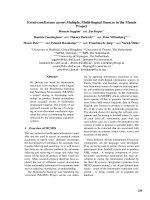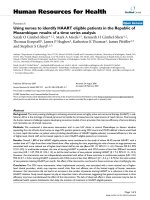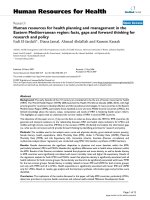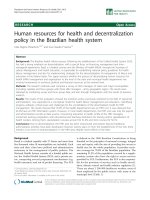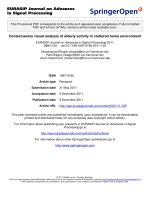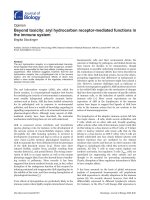Báo cáo sinh học: "Process rather than pattern: finding pine needles in the coevolutionary haystack" doc
Bạn đang xem bản rút gọn của tài liệu. Xem và tải ngay bản đầy đủ của tài liệu tại đây (658.52 KB, 5 trang )
Minireview
PPrroocceessss rraatthheerr tthhaann ppaatttteerrnn:: ffiinnddiinngg ppiinnee nneeeeddlleess iinn tthhee ccooeevvoolluuttiioonnaarryy
hhaayyssttaacckk
David R Nash
Address: Centre for Social Evolution, Department of Biology, University of Copenhagen, Universitetsparken 15, DK-2100 Copenhagen,
Denmark. E-mail:
Coevolution is a powerful concept in biology. It explains
why cheetahs run fast, and why gazelles run fast too [1]. It
explains why the flowers of some orchids have extraordi-
narily long spurs to store their nectar, and why the moths
that pollinate them have extraordinarily long tongues to
drink it [2]. It explains why we don’t all succumb to diseases,
and why diseases still exist [3]. Most evolutionary change
may well be coevolutionary change [4].
How coevolution actually works is far from clear, however,
if one looks into it in any depth. How is the genetic varia-
tion that is the raw material of coevolution, or any other
sort of evolution for that matter, maintained when faster or
longer is always better? How can genetically homogeneous
populations attacked by pathogens survive long enough to
mount a coevolutionary response? The answers may lie in
the fact that the world is not made up of single populations
of organisms freely exchanging genes. Instead, populations
are not the same everywhere, and interactions between
organisms are not the same everywhere. As is clear from our
own species’ experience with its coevolving pathogens [5],
things vary geographically.
It was thinking about such questions over the past two
decades that led John Thompson to propose his geographic
mosaic theory of coevolution [6,7]. Although this theory has
been widely discussed and has become a unifying framework
for many coevolutionary studies, it is still often misunder-
stood [8]. That there are differences between how organisms
interact at different spots on Earth is, in itself, a fairly trivial
observation, but Thompson’s big idea is that without those
differences, there would be no coevolution. The geographic
mosaic drives coevolution, rather than being merely a
consequence of the fragmentation of interacting populations.
Pattern and process are quite distinct in the theory, but they
are often confused in practice. It is significant that Thomp-
son’s book The Coevolutionary Process [6], which first brought
his theory to most of the scientific community, emphasizes
process rather than pattern. The processes underlying the
geographic mosaic theory of coevolution are difficult to test
experimentally, but a new study in BMC Biology [9] of pines
and their mycorrhizal fungi, provides the first experimental
support for one of the key processes.
PPrroocceesssseess
The geographic mosaic theory of coevolution puts forward
three distinct processes that are conjectured to be the basis
of coevolutionary change (Figure 1): coevolutionary hot
and cold spots, selection mosaics and trait-mixing.
AAbbssttrraacctt
The geographic mosaic theory is fast becoming a unifying framework for coevolutionary
studies. A recent experimental study of interactions between pines and mycorrhizal fungi in
BMC Biology
is the first to rigorously test geographical selection mosaics, one of the corner-
stones of the theory.
BioMed Central
Journal of Biology
2008,
77::
14
Published: 28 May 2008
Journal of Biology
2008,
77::
14 (doi:10.1186/jbiol75)
The electronic version of this article is the complete one and can be
found online at />© 2008 BioMed Central Ltd
The strength of coevolution varies between populations of
interacting organisms. In some areas, termed hot spots,
coevolutionary selection is intense, whereas in cold spots,
the interacting species evolve independently of each other
[10]. This can be for the simple reason that one of the
interacting partners is absent in a cold spot, as is often the
case with parasitic interactions in which not every host
population is parasitized [11,12]. Cold spots can also exist
for other reasons, for example because alternative hosts are
present that are preferred by a parasite [13]. There is a
continuum between cold and hot spots, with the strength of
coevolutionary selection increasing as spots become pro-
gressively ‘hotter’.
Selection mosaics are also important for the theory, but
these have often been misunderstood. It is not enough that
the strength of coevolutionary selection varies between
populations, it is also necessary that the direction of that
selection varies, so that the outcomes of coevolution are
different in different populations, depending on their
environment. In other words, the costs and benefits to both
partners of any particular adaptation are dependent not
only on the adaptations of their partner, but also on the
environment in which the interaction occurs. This is perhaps
most easily seen in what have been termed ‘conditional
mutualisms’ [14], in which interactions can be mutualistic,
commensal or parasitic depending on the ecological con-
ditions in which the partners interact [15-17]. The variation
does not, however, need to be so great as to lead to shifts
between parasitism and mutualism, but outcomes are
dependent on the interactions of the adaptations of both
partners with the environment that they find themselves in.
Hence, the selection mosaic is a result of gene × gene ×
environment (G × G × E) interactions [8,18]. The different
outcomes in different environments can be due either to
abiotic factors [19] or to biotic factors, such as the presence
and density of a predator or competitor [13,20,21].
Finally, in order for the coevolutionary process to work,
there must be a mechanism that allows traits that have
evolved in one population to be transferred to and mixed
with traits that have evolved in other areas. In other words,
there must be gene flow between populations to enable
genes that are favorable to track the conditions in which
they are favorable, and to allow the maintenance of genetic
variation that would otherwise disappear [11,22]. Gene
flow must also be at the right level; too much mixing, and
there will never be a response to selection because the best
adapted genes are always swamped by the inflow of non-
adaptive genes; too little mixing, however, will allow
specific alleles to go to fixation so that, barring novel
mutations, the coevolutionary process will grind to a halt
[13,23,24].
PPaatttteerrnnss
As well as the three processes involved in coevolutionary
mosaics, there are several patterns that are expected to result
from the process. For example, it is expected that there will
be spatial variation in the traits that are involved with
interspecific interactions [25]; that in some areas, traits will
be mismatched (local maladaptation) [26]; and finally that
there will be few species-level traits that have become fixed
as a result of coevolution [27]. These patterns are often used
as evidence for the presence of a geographic mosaic of co-
evolution, but they can also result from other, non-coevolu-
tionary processes. In a key paper last year, Richard Gomul-
14.2
Journal of Biology
2008, Volume 7, Article 14 Nash />Journal of Biology
2008,
77::
14
FFiigguurree 11
The three components of the geographic mosaic of coevolution.
((aa))
Populations of interacting species are distributed in a spatial mosaic,
with the strength of coevolutionary selection exerted by each partner
on the other varying between populations. In cold spots (here
represented by light-colored tiles), the traits of each species evolve
independently, whereas in hot spots (dark tiles) coevolutionary
selection is intense.
((bb))
As well as varying in strength, the direction of
selection varies spatially (there is a selection mosaic; represented here
as different colored tiles), depending on the interactions between the
genotypes of both interacting species and the local environment.
((cc))
There is some mixing of genes due to the dispersal of individuals
between populations (represented as the individual dots making up the
shaded areas). The level of mixing must be sufficient to allow the
occasional introduction of new genotypes into populations, but low
enough that adaptations are not swamped by gene flow from
populations experiencing different selection pressures or strengths.
((dd))
The combination of all three elements leads to a system in which
coevolution is a continuous dynamic process that, at the same time,
retains ample genetic variation to allow long-term coevolution.
(a) (b)
(c)
(d)
kiewicz and co-workers [8] set out a rather daunting mani-
festo for how the geographic mosaic theory of coevolution
should be tested and, specifically, how the presence of
geographic mosaics of coevolution can be demonstrated. So
far there are no studies that have fulfilled all the
requirements that have been set forth for testing the theory.
TTeessttiinngg tthhee pprroocceesssseess ooff tthhee ccooeevvoolluuttiioonnaarryy mmoossaaiicc
There have been several studies inferring hot and cold spots
of coevolutionary selection [11,13,28,29], and others
characterizing gene flow between populations involved in
interspecific interactions [13,30,31], but most studies have
been observational rather than experimental, so that process
and pattern cannot be disentangled. The area of the theory
to which this limitation applies most is the demonstration
of selection mosaics, and as a result these have received
little rigorous attention. Resolving this deficiency has been
the focus of the paper in BMC Biology [9], which is the first
to examine explicitly the G × G × E interactions required for
a selection mosaic to generate coevolutionary change.
The study system chosen was the interaction between bishop
pine (Pinus muricata) and the ectomycorrhizal fungus Rhizo-
pogon occidentalis. Interactions between plants and mycor-
rhizae are strong candidates for model systems to test the
/>Journal of Biology
2008, Volume 7, Article 14 Nash 14.3
Journal of Biology
2008,
77::
14
FFiigguurree 22
Summary of the findings of Piculell
et al
. [9], showing the measured fitness components of two maternal half-sib families of bishop pine plants (M18
and M19, measured as relative growth rate and root length) and two full-sib families of its mycorrhizal fungus (132 and 133, measured as the number
of roots of the host that are inoculated) under four different environments. The height of each symbol is proportional to the measured performance
value. The performance of both partners in the interaction varies depending on both the lineage of partner they are interacting with and the environ-
ment. This is most clearly seen for fungal performance in field soil, where the number of host roots inoculated varies by an order of magnitude.
Lab soil Field soil
Sterile soil Soil + microbes
Abiotic environment
Biotic environment
Relative growth
rate
Final root
length
Number of fungus-
colonized root tips
132 331
M1981M
Key
Pine lineage
Fungus lineage
geographic mosaic theory of coevolution, because there are
several clear cases of conditional mutualism in which not
only the magnitude but also the nature of interaction
(mutualistic or antagonistic) varies between different ecolo-
gical situations [32-34].
In a simple but elegant factorial experimental design, Piculell
et al. [9] tested the interaction between two different
lineages of pine and two lineages of fungus in four environ-
ments, representing a factorial combination of two different
abiotic environments (two different sterile soil types) and
two different biotic environments (the presence or absence
of potentially competing soil microorganisms). Measuring
various fitness components of the pines and fungi showed
that there were variable outcomes for the same combina-
tions of pine and fungus lineages under different conditions
(Figure 2) and that for one of the pine families, this could
indeed result in a mutualistic or parasitic interaction
depending on the environment [9].
So, why have such studies not been carried out before? One
simple answer is that the need for such studies has only
become apparent recently. Another problem is the scale of
experimental manipulation required for such studies.
Piculell and co-workers [9] needed to successfully raise 128
combinations of pine and fungus, and this was still not
quite sufficient to detect any statistically significant G × G ×
E effects (although the G × G × biotic environment effects
on relative growth rate and shoot:root ratio were close; P =
0.066 and P = 0.059 respectively; see Additional file 2 in
[9]). In other systems, in which changes in interaction
strength and direction are likely to be more subtle, the
experimental replication required for tests powerful
enough to demonstrate selection mosaics is intimidating.
So, although theoretical studies of the geographic mosaic
theory of coevolution are multiplying, it is almost
inevitable that empirical studies are lagging behind and
tend to be concerned with confirming the predicted
patterns rather than experimentally testing the process.
Translating the outcomes of experimental studies such as
that of Piculell et al. [9] into real-world coevolutionary
mosaics at the appropriate geographic scale remains a
distant goal. In the meantime, large-scale studies of
geographical patterns are still crucial for solidifying the
foundations of the theory, and for parameterizing the next
generation of theoretical models.
AAcckknnoowwlleeddggeemmeennttss
I thank Koos Boomsma for valuable discussion and comments. Funding
for the Centre for Social Evolution is provided by the Danish National
Research Foundation.
RReeffeerreenncceess
1. Dawkins R:
River Out of Eden: A Darwinian View of Life.
New
York: Basic Books; 1995.
2. Darwin C:
The Various Contrivances by which Orchids are Fer-
tilised by Insects
(2nd, revised edition). London: John Murray;
1877.
3. Haldane JBS:
DDiisseeaassee aanndd eevvoolluuttiioonn
La Ricerca Scientifica
1949,
1199::
3-10.
4. Van Valen L:
HHooww ppeerrvvaassiivvee iiss ccooeevvoolluuttiioonn??
In
Coevolution.
Edited
by Nitecki MH. Chicago: University of Chicago Press; 1983: 1-19.
5. Diamond JM:
Guns, Germs and Steel: The Fates of Human Soci-
eties.
London: Jonathan Cape; 1997.
6. Thompson JN:
The Coevolutionary Process.
Chicago: University
of Chicago Press; 1994.
7. Thompson JN:
The Geographic Mosaic of Coevolution.
Chicago:
University of Chicago Press; 2005.
8. Gomulkiewicz R, Drown DM, Dybdahl MF, Godsoe W, Nuismer
SL, Pepin KM, Ridenhour BJ, Smith CI, Yoder JB:
DDooss aanndd ddoonn’’ttss ooff
tteessttiinngg tthhee ggeeooggrraapphhiicc mmoossaaiicc tthheeoorryy ooff ccooeevvoolluuttiioonn
Heredity
2007,
9988::
249-258.
9. Piculell B, Hoeksema JD, Thompson JN:
IInntteerraaccttiioonnss ooff bbiioottiicc aanndd
aabbiioottiicc eennvviirroonnmmeennttaall ffaaccttoorrss oonn aann eeccttoommyyccoorrrrhhiizzaall ssyymmbbiioossiiss,,
aannd
d tthhee ppootteennttiiaall ffoorr sseelleeccttiioonn mmoossaaiiccss
BMC Biol
2008,
66::
23.
10. Gomulkiewicz R, Thompson JN, Holt RD, Nuismer SL, Hochberg
ME:
HHoott ssppoottss,, ccoolldd ssppoottss,, aanndd tthhee ggeeooggrraapphhiicc mmoossaaiicc tthheeoorryy ooff
ccooeevvoolluuttiioonn
Am Nat
2000,
115566::
156-174.
11. Brockhurst MA, Buckling A, Poullain V, Hochberg ME:
TThhee iimmppaacctt
ooff mmiiggrraattiioonn ffrroomm ppaarraassiittee ffrreeee ppaattcchheess oonn aannttaaggoonniissttiicc hhoosstt ppaarraa
ssiittee ccooeevvoolluutti
ioonn
Evolution
2007,
6611::
1238-1243.
12. Nuismer SL, Thompson JN, Gomulkiewicz R:
CCooeevvoolluuttiioonn
bbeettwweeeenn hhoossttss aanndd ppaarraassiitteess wwiitthh ppaarrttiiaallllyy oovveerrllaappppiinngg ggeeooggrraapphhiicc
rraannggeess
J Evol Biol
2003,
1166::
1337-1345.
13. Nash DR, Als TD, Maile R, Jones GR, Boomsma JJ:
AA mmoossaaiicc ooff
cchheemmiiccaall ccooeevvoolluuttiioonn iinn aa llaarrggee bblluuee bbuutttteerrffllyy
Science
2008,
331199::
88-90.
14. Cushman JH, Whitham TG:
CCoonnddiittiioonnaall mmuuttuuaalliissmm iinn aa mmeemm
bbrraacciidd aanntt aassssoocciiaattiioonn:: TTeemmppoorraall,, aaggee ssppeecciiffiicc,, aanndd ddeennssiittyy-
-ddeeppeenn
ddeenntt eeffffeeccttss
Ecology
1989,
7700::
1040-1047.
15. Offenberg J:
BBaallaanncciinngg bbeettwweeeenn mmuuttuuaalliissmm aanndd eexxppllooiittaattiioonn:: tthhee
ssyymmbbiioottiicc iinntteerraaccttiioonn bbeettwweeeenn LLaassiiuuss aannttss a
anndd aapphhiiddss
Behav Ecol
Sociobiol
2001,
4499::
304-310.
16. van Ommeren RJ, Whitham TG:
CChhaannggeess iinn iinntteerraaccttiioonnss bbeettwweeeenn
jjuunniippeerr aanndd mmiissttlleettooee mmeeddiiaatteedd bbyy sshhaarreedd aavviiaann ffrruuggiivvoorreess:: ppa
arraa
ssiittiissmm ttoo ppootteennttiiaall mmuuttuuaalliissmm
Oecologia
2002,
113300::
281-288.
17. Styrsky JD, Eubanks MD:
EEccoollooggiiccaall ccoonnsseeqquueenncceess ooff iinntteerraaccttiioonnss
bbeettwweeeenn aannttss aanndd hhoonneeyyddeeww pprroodduucciinngg iinnsseeccttss
Proc Biol Sci
2007,
227744::
151-164.
18. Wade MJ:
TThhee ccoo eevvoolluuttiioonnaarryy ggeenneettiiccss ooff eeccoollooggiiccaall ccoommmmuunniittiieess
Nat Rev Genet
2007,
88::
185-195.
19. Kersch MF, Fonseca CR:
AAbbiioottiicc ffaaccttoorrss aanndd tthhee ccoonnddiittiioonnaall
oouuttccoommee ooff aann aanntt ppllaanntt mmuuttuuaalliissmm
Ecology
2005,
8866::
2117-2126.
20. Gaume L, McKey D, Terrin S:
AAnntt ppllaanntt hhoommoopptteerraann mmuuttuuaalliissmm::
hhooww tthhee tthhiirrdd ppaarrttnneerr aaffffeeccttss tthhee iinntteerraaccttiioonn bbeettwweeeenn aa ppllaannt
t ssppee
cciiaalliisstt aanntt aanndd iittss mmyyrrmmeeccoopphhyyttee hhoosstt
Proc Biol Sci
1998,
226655::
569-
575.
21. Benkman CW, Holimon WC, Smith JW:
TThhee iinnfflluueennccee ooff aa ccoomm
ppeettiittoorr oonn tthhee ggeeooggrraapphhiicc mmoossaaiicc ooff ccooeevvoolluuttiioonn bbeettwweeeenn ccrroossss
bbiilll
lss aanndd llooddggeeppoollee ppiinnee
Evolution
2001,
5555::
282-294.
22. Nuismer SL, Thompson JN, Gomulkiewicz R:
GGeennee ffllooww aanndd ggeeoo
ggrraapphhiiccaallllyy ssttrruuccttuurreedd ccooeevvoolluuttiioonn
Proc Biol Sci
1999,
226666::
605-
609.
23. Anderson B, Olivieri I, Lourmas M, Stewart BA:
CCoommppaarraattiivvee ppoopp
uullaattiioonn ggeenneettiicc ssttrruuccttuurreess aanndd llooccaall aaddaappttaattiioonn ooff ttwwoo mmuuttuuaalliissttss
Evolution
2004,
5588::
1730-1747.
24. Dupas S, Carton Y, Poirie M:
GGeenneettiicc ddiimmeennssiioonn ooff tthhee ccooeevvoolluu
ttiioonn ooff vviirruulleennccee rreessiissttaannccee iinn
DDrroossoopphhiillaa
ppaarraassiittooiidd wwaasspp rreellaa
ttiioonnsshhiippss
Heredity
2003,
9900::
84-89.
25. Alcantara JM, Rey PJ, Manzaneda AJ, Boulay R, Ramirez JM, Fedri-
ani JM:
GGeeooggrraapphhiicc vvaarriiaattiioonn iinn tthhee aaddaappttiivvee llaannddssccaappee ffoorr sseeeedd ssiizzee
aatt ddiissppeerrssaall iinn tthhee mmyyrrmmeeccoocchhoorroouuss
HHeelllleebboorruuss ffooeettiidduuss
Evol Ecol
2007,
2211::
411-430.
26. Thompson JN, Nuismer SL, Gomulkiewicz R:
CCooeevvoolluuttiioonn aanndd
mmaallaaddaappttaattiioonn
Integr Comp Biol
2002,
4422::
381-387.
14.4
Journal of Biology
2008, Volume 7, Article 14 Nash />Journal of Biology
2008,
77::
14
27. Thompson JN:
SSppeecciiffiicc hhyyppootthheesseess oonn tthhee ggeeooggrraapphhiicc mmoossaaiicc ooff
ccooeevvoolluuttiioonn
Am Nat
1999,
115533::
S1-S14.
28. Benkman CW:
TThhee sseelleeccttiioonn mmoossaaiicc aanndd ddiivveerrssiiffyyiinngg ccooeevvoolluuttiioonn
bbeettwweeeenn ccrroossssbbiillllss aanndd llooddggeeppoollee ppiinnee
Am Nat
1999,
115533::
S75-S91.
29. Brodie ED, Ridenhour BJ:
TThhee eevvoolluuttiioonnaarryy rreessppoonnssee ooff pprreeddaattoorrss
ttoo ddaannggeerroouuss pprreeyy:: hhoottssppoottss aanndd ccoollddssppoottss iinn tthhee ggeeooggrraapphhiicc
mmoossaaiicc ooff ccooeevvoolluuttiioonn bbeettwweeeenn ggaarrtteerr ssnnaakkeess aanndd nneewwttss
Evolution
2002,
5566::
2067-2082.
30. Brandt M, Fischer-Blass B, Heinze J, Foitzik S:
PPooppuullaattiioonn ssttrruuccttuurree
aanndd tthhee ccoo eevvoolluuttiioonn bbeettwweeeenn ssoocciiaall ppaarraassiitteess aanndd tthheeiirr hhoossttss
Mol
Ecol
2007,
1166::
2063-2078.
31. Martin-Galvez D, Soler JJ, Martinez JG, Krupa AP, Soler M, Burke
T:
CCuucckkoooo ppaarraassiittiissmm aanndd pprroodduuccttiivviittyy iinn ddiiffffeerreenntt mmaaggppiiee ssuubbppoopp
uullaattiioonnss pprreeddiicctt ffrreeqquueenncciieess ooff tthhee 445577bbpp aalllleellee:: aa mmoossaaiicc ooff ccooeevvoo
lluuttiioonn aatt aa ssmmaallll ggeeooggrraapphhiicc ssccaallee
Evolution
2007,
6611::
2340-2348.
32. Egger KN, Hibbett DS:
TThhee eevvoolluuttiioonnaarryy iimmpplliiccaattiioonnss ooff eexxppllooiittaa
ttiioonn iinn mmyyccoorrrrhhiizzaass
Can J Bot
2004,
8822::
1110-1121.
33. Hoeksema JD, Thompson JN:
GGeeooggrraapphhiicc ssttrruuccttuurree iinn aa wwiiddee
sspprreeaadd ppllaanntt mmyyccoorrrrhhiizzaall iinntteerraaccttiioonn:: ppiinneess aanndd ffaallssee ttrruufffflleess
J Evol
Biol
2007,
2200::
1148-1163.
34. Kiers ET, Lovelock CE, Krueger EL, Herre EA:
DDiiffffeerreennttiiaall eeffffeeccttss
ooff ttrrooppiiccaall aarrbbuussccuullaarr mmyyccoorrrrhhiizzaall ffuunnggaall iinnooccuullaa oonn rroooott ccoolloonniizzaa
ttiioonn aanndd ttrreeee sseeeeddlliinngg ggrroowwtthh:: iimmpplliiccaattiioonnss ffoorr ttrrooppiiccaall ffoorreesstt
ddiivveerrssiittyy
Ecol Lett
2000,
33::
106-113.
/>Journal of Biology
2008, Volume 7, Article 14 Nash 14.5
Journal of Biology
2008,
77::
14
